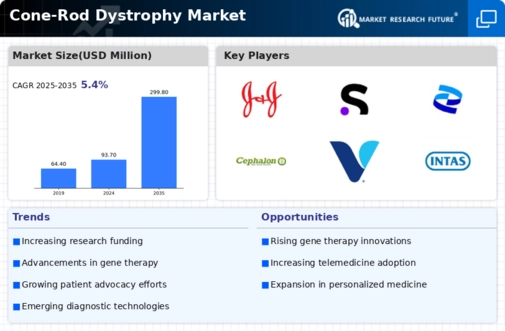Market Growth Projections
The Global Cone-Rod Dystrophy Market Industry is projected to experience substantial growth over the next decade. With a market size anticipated to reach 299.8 USD Million by 2035, the industry is poised for significant expansion. The compound annual growth rate of 11.15% from 2025 to 2035 underscores the increasing investment in research, development, and innovative therapies. This growth trajectory reflects the collective efforts of stakeholders in addressing the challenges associated with cone-rod dystrophy, including the need for effective treatments and improved patient outcomes. The market's evolution is likely to be influenced by ongoing advancements in technology and heightened awareness.
Advancements in Gene Therapy
Recent advancements in gene therapy are poised to revolutionize the Global Cone-Rod Dystrophy Market Industry. Innovative approaches, such as CRISPR and viral vector technologies, are being explored to correct genetic mutations responsible for the disorder. These therapies offer the potential for long-term vision restoration, which could significantly improve the quality of life for affected individuals. Clinical trials are underway, and positive outcomes may lead to increased investment in research and development. As these therapies progress, the market is likely to experience substantial growth, with projections indicating a market size of 299.8 USD Million by 2035.
Rising Awareness and Advocacy
Rising awareness and advocacy for cone-rod dystrophy are pivotal in shaping the Global Cone-Rod Dystrophy Market Industry. Patient advocacy groups and non-profit organizations are actively promoting education about the disorder, which helps in early diagnosis and treatment. This increased awareness is likely to lead to higher patient engagement in clinical trials and research studies, further driving market growth. Additionally, awareness campaigns are fostering collaboration between stakeholders, including researchers, healthcare providers, and pharmaceutical companies, to expedite the development of effective therapies. This collaborative environment is essential for addressing the challenges posed by this rare condition.
Emerging Technologies in Diagnostics
Emerging technologies in diagnostics are transforming the Global Cone-Rod Dystrophy Market Industry. Innovations such as advanced imaging techniques and genetic testing are enabling earlier and more accurate diagnoses of cone-rod dystrophy. These advancements facilitate timely intervention, which is crucial for preserving vision and improving patient outcomes. As diagnostic capabilities expand, healthcare providers are better equipped to identify affected individuals, leading to increased demand for subsequent therapeutic options. The integration of these technologies into clinical practice is expected to enhance the overall management of the disorder, thereby contributing to market growth.
Growing Investment in Rare Disease Research
The Global Cone-Rod Dystrophy Market Industry benefits from a surge in investment directed towards rare disease research. Governments and private organizations are increasingly recognizing the need to address unmet medical needs in this area. Funding initiatives and grants are being allocated to support research aimed at understanding the underlying mechanisms of cone-rod dystrophy and developing targeted therapies. This influx of capital is expected to accelerate the pace of innovation, leading to the introduction of new treatment modalities. As a result, the market is likely to see a compound annual growth rate of 11.15% from 2025 to 2035.
Increasing Prevalence of Cone-Rod Dystrophy
The Global Cone-Rod Dystrophy Market Industry is witnessing a rise in the prevalence of this rare genetic disorder, which affects the photoreceptor cells in the retina. As awareness increases, more individuals are being diagnosed, leading to a growing patient population. This trend is particularly evident in regions with enhanced genetic screening programs. The increasing number of diagnosed cases is expected to drive demand for innovative therapies and diagnostic tools, contributing to the market's expansion. In 2024, the market is projected to reach 93.7 USD Million, reflecting the urgent need for effective treatment options.




















Leave a Comment